Metadata View
To make the SAAo/SAA17 subproject more a little more user friendly, we have customized the metadata frame of the Item View (see the image below) so that more information about the texts included in this subproject are accessible to SAAo users. This page will give a brief overview of the information now provided in the metadata frame of the Item View.
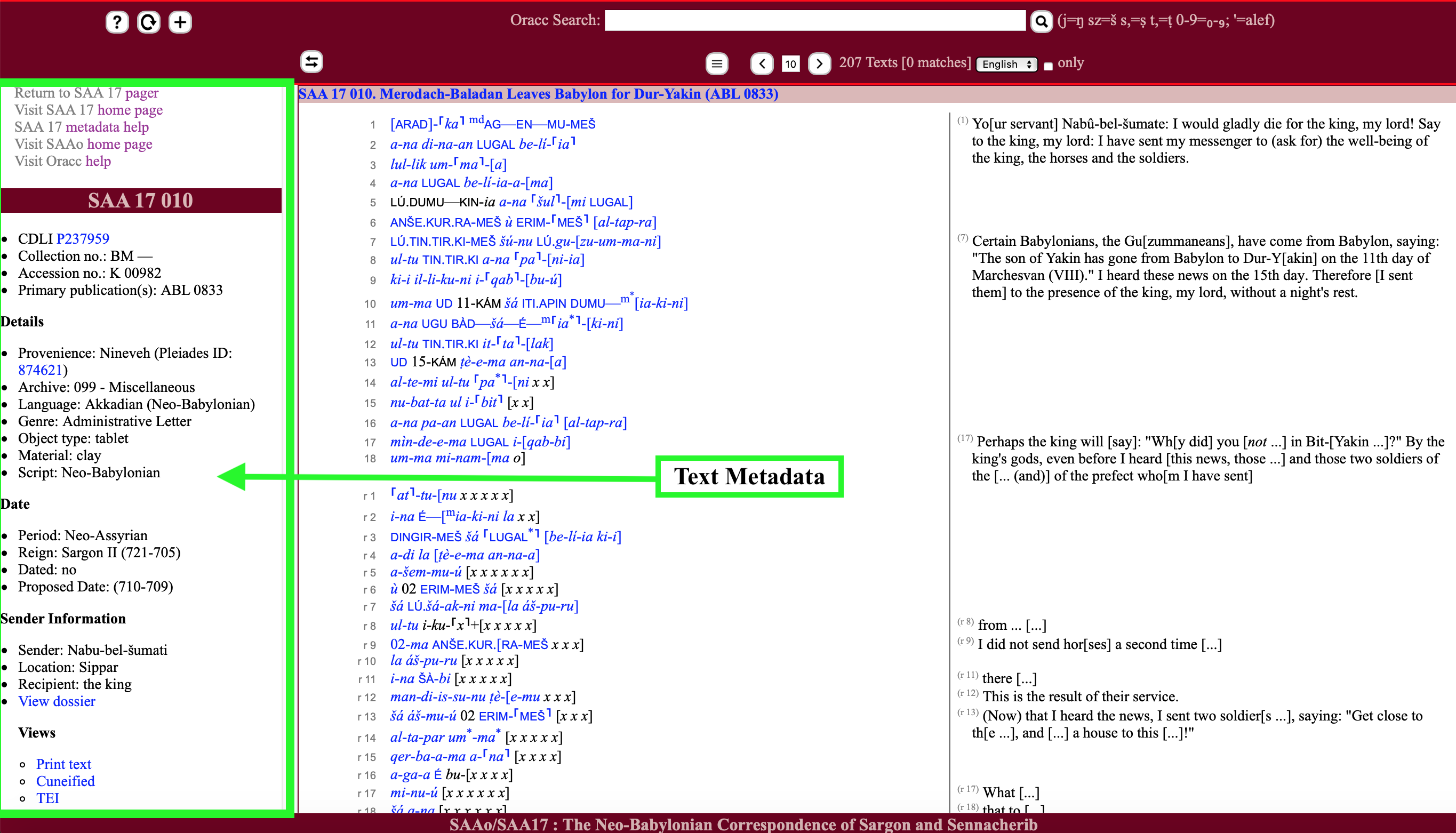
General Information Links
This section contains four links:
- a link to return to the SAA 17 pager [/saao/saa17/pager];
- a link to the SAA 17 home page [/saao/saa17/];
- a link to main SAAo home page [/saao/]; and
- a link to the Oracc help pages [http://oracc.museum.upenn.edu/doc/help/index.html].
Designation
The text designation, which is displayed in the deep red background, comprises the SAA volume number (here, "SAA 17") and the text number within that publication (with leading zeros). For example, text 10 ("Merodach-Baladan Leaves Babylon for Dur-Yakin (ABL 0833)") has the designation "SAA 17 010."
Numbers
The numbers section displays the following information (when known):
- a hyperlinked CDLI number ("P" plus six digits), which loads the CDLI record for the object;
- the tablet's collection and accession number;
- the objects excavation number; and
- the text's primary publication(s) (usually the ABL or CT 54 number).
The collection, accession, and excavation numbers follow CDLI formatting. For example, K 982 (=SAA 17 010) displays as K 00982 (with two leading zeros). Leading zeros are also used for the primary publications. Thus, ABL 0833 for ABL 833.
Details
The details section contains general information about the text, including find spot, language (dialect), and material support. The metadata included here is:
- Provenience, with a link to the place resource on Pleiades [https://pleiades.stoa.org], a community-built gazetteer and graph of ancient places;
- the archival context of the find spot of the letter, if known;
- the language and dialect of the text (always "Akkadian (Neo-Babylonian)");
- genre of the text (always "Administrative Letter");
- object type (always "tablet");
- material support (always "clay"); and
- script (always "Neo-Babylonian").
Date
The date section includes the following information, when known:
- period (always "Neo-Assyrian");
- ruler and regnal dates, which is "Sargon II (721-705)," "Sennacherib (704-681)," or "Sargon II (721-705) or Sennacherib (704-681)" for this SAAo subproject;
- a statement noting that the letters edited in SAA 17 are not dated (= "dated: no"); and
- the date of composition proposed by Manfried Dietrich in the introduction of SAA 17, when a date has been suggested.
As noted above, none of the letters edited in SAA 17 have a date written on them and, therefore, all of the dates in the date field are modern, scholarly suggestions (here, generally following Manfried Dietrich). To help SAAo/SAA17 users easily identify which texts bear an ancient date and which texts have been assigned an ancient date by scholars, proposed dates are displayed between parentheses in the SAAo/SAA17 pager [/saao/saa17/pager] (fifth column) and
in the metadata pane of the Item View [/saao/saa17/P238347]. For example, SAA 17 023 is not dated, but Manfried Dietrich has suggested that that letter was written by Bel-iqiša to the king (Sargon II) in 710. Thus, the "date" of this non-dated letter is given as (710). In the Item View, the "Dated" metadata field of such texts will be displayed as Dated: no and state the date provided is the Proposed Date.
Note that the information provided for the "reign" is based solely on the information given for the "(proposed) date." For SAA 17, the reign will be Sargon II (721-705), Sennacherib (704-681), or Sargon II (721-705) or Sennacherib (704-681).
Sender Information
The sender information section contains the following:
- the name of the sender(s), when known;
- the (proposed) location of the sender(s);
- the name/title of the recipient of the letter, when known/preserved;
- a link to view the sender's dossier.
In the example shown in the screenshot above, Nabu-bel-šumati is the author of SAA 17 010. When one clicks on the "View dossier [/saao/saa17/nabu-bel-shumati]" link in the metadata pane of that text, Oracc will load a new tab displaying the seven letters assigned to Nabu-bel-šumati, including a joint letter written by him and another official (whose name is now completely lost).
The names/titles of the sender and recipient are
displayed according to the information provided in the letters themselves. For example, the sender of SAA 17 010 [/saao/saa17/P237959] is the Nabû-bel-šumate, while the recipient is the king. As for the (assumed) identity of "the king," this information is displayed in the "reign" field; based on this letter's contents, which reports that the 'son of Yakin' (who is identified with the Babylonian king Marduk-apla-iddina II) left Babylon for Dur-Yakin, it is very likely that that "the king" is Sargon II. Partially preserved names contain square brackets, thereby showing how much of the names are actually preserved on the tablets and how much of the names are restored by modern scholars; for example, [Nabû-a]hhe-lumur is the sender of SAA 17 007 [/saao/saa17/P238121]. Fully restored names, which are (often) conjectural, appear entirely between square brackets; for example, [Bel-iqiša] is the restored and assumed sender of SAA 17 023 [/saao/saa17/P238347].
The (sender) locations are assumed and they (generally) follow the
dossier assignments provided by the SAA authors. In the case of SAA
17, Assyria is
provisionally given as the sender's location when the letter is sent
by the king since the
tablet could have been sent from Calah, Dur-Šarrukin, or Nineveh.
Bibliography
When additional bibliography is included in SAA 17, those publications will be listed under the bibliography section. The abbreviations are explained on the SAA 17 Abbreviations and Symbols [/saao/saa17/saa17abbreviationsandsymbols/index.html] page.
Views
At present, two views of the text are possible:
- Print text, which allows users to print the transliteration and translation of the text; and
- Cuneified, which opens a new browser displaying the text in a computer-generated Neo-Assyrian font.
The SAAo/SAA21 catalogue has sixty-six searchable fields. These are:abl_no, accession_no, adb_no, add_no, ags_no, ancient_author, ancient_recipient, archive, astron_date, cdli_id, ch_name, ch_no, ch_num_name, collection, credits, ct_53_no, ct_54_no, ctn_no, date, designation, dialect, display_name, dossier_list, excavation_no, genre, gpa_no, has_date, id_text, kah_no, kar_no, kav_no, language, las_no, lka_no, long_date, material, museum_no, nargd_no, nl_no, object_type, other_pub, period, pkt_no, pkta_no, please_cite, pleiades_id, pleiades_sender_loc, primary_publication, prov_coordinates, provenience, prt_no, publication_history, regnal_dates, rma_no, ruler, script, script_remarks, script_type, sender_loc, sender_loc_coordinates, short_title, stt_no, subgenre, tim_11_no, title, vol_title, volume.
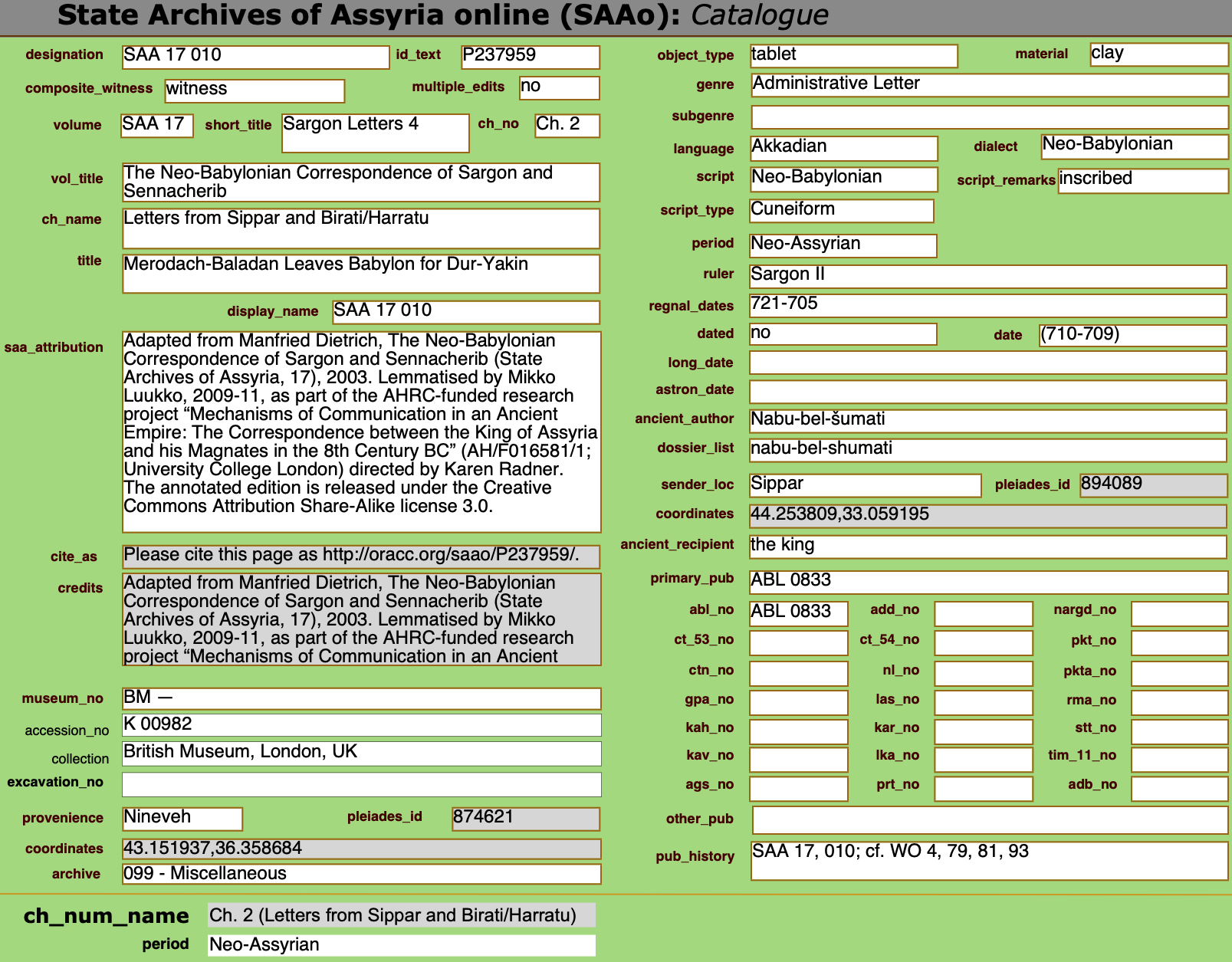
You can search any of these fields in the SAAo/SAA17 pager by using the Oracc Search window.
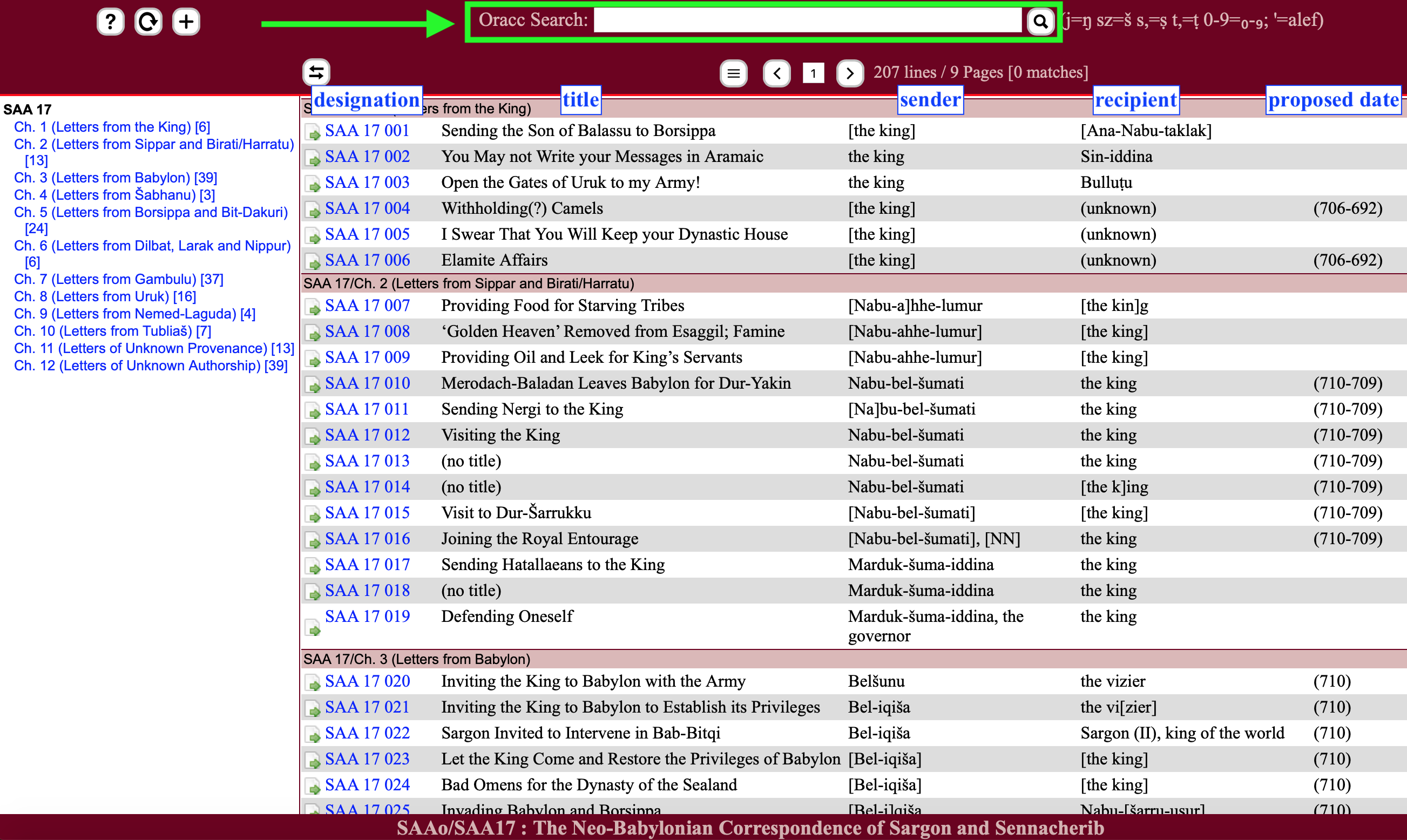
You can search the entire database or a specific field. To search the entire catalogue, enter catalogue: into the Oracc Search bar and the search criteria. For example, catalogue:Sippar.
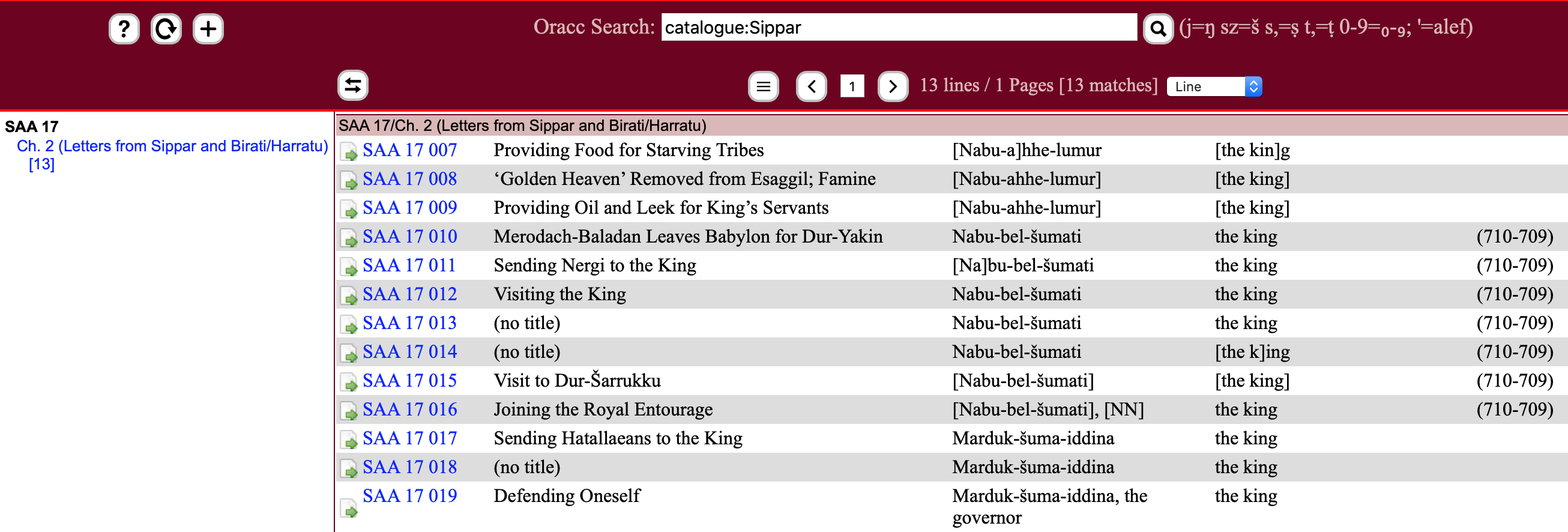
NOTE: If your search comprises more than one word, then use an underscore (_) instead of a blank space between the words. For example, catalogue:Sargon_II_or_Sennacherib.
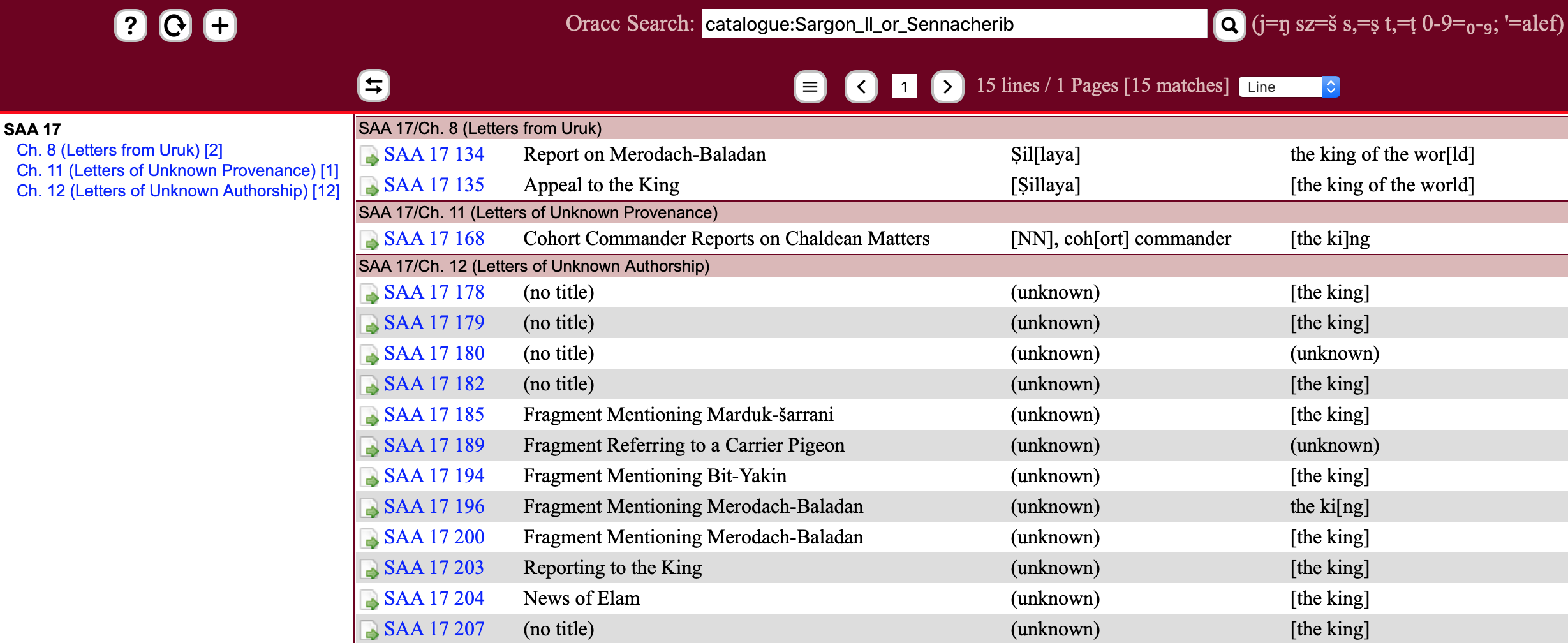
If you want to only search one field, enter the field name (without the underscrores) plus : and then the search criteria. For example, ancientauthor:Nabu-bel-šumati; ancientauthor:Nabu-bel-szumati (with sz instead of š) and ancientauthor:Nabubelszumati (with sz instead of š and without hyphens) will also return results.

Jamie Novotny
Jamie Novotny, 'Metadata View', The Neo-Babylonian Correspondence of Sargon and Sennacherib, SAA 17. Original publication: Helsinki, Helsinki University Press, 2003; online contents: SAAo/SAA17 Project, a sub-project of MOCCI, 2020 [http://oracc.org/saao/saa17/saa17metadataview/]